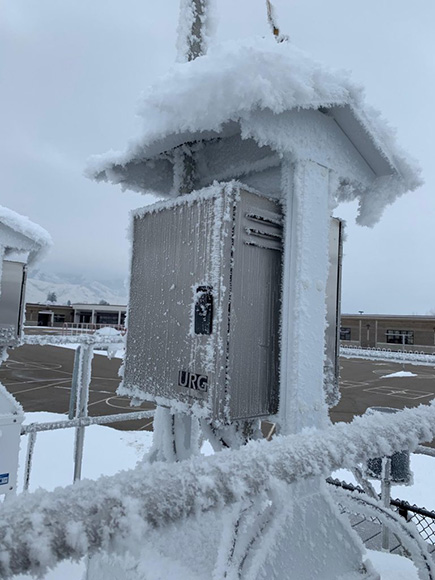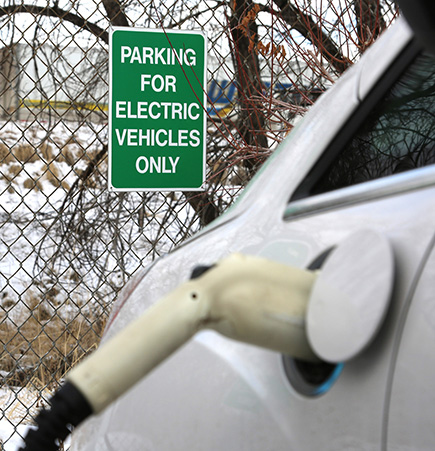Answers to Utah’s Inversion Season Frequently Asked Questions compiled by the Utah Division of Air Quality, originally published December 14, 2020.
By DEQ Communications Staff
Utah’s air quality meets federal health standards most of the year, but during the winter we experience “inversions” caused by a combination of topography, regional weather patterns, and emissions from various sources. Below you will find answers to some of the most frequently asked questions about Utah’s winter air quality. Have a question that isn’t covered here? Contact Ashley Sumner at [email protected].
What causes the winter inversions that lead to poor air quality in Utah?
Utah’s winter inversions are a combination of several factors. Under normal conditions, air temperatures decrease with altitude. In the winter, when the ground is covered in snow that reflects heat, nights are longer, and the sun is supplying less warmth to the earth, temperatures can “invert” with warmer air on top of cooler air. When inverted temperatures combine with calm winds that reduce the natural mixing of cold and warm air, it creates a warm air “lid” that traps pollutants in Utah’s valleys, causing an inversion.
This is why Utah inversions often occur after a snowstorm. The snow cools the ground, and clear skies warm the upper atmosphere. Mountains can also increase the strength of inversions in the valleys because they form a basin that traps cold air and shields it from the stronger winds that could clear out an inversion.

What is PM2.5?
PM2.5 emissions and the chemicals that create emissions are the primary cause of winter inversions in Utah. PM stands for particulate matter, a mixture of liquid droplets and solid particles found in the air. PM2.5 is particulate matter that measures less than 2.5 microns in diameter, about 3% of the diameter of a human hair. Because of their small size, they can be inhaled and enter the lungs and even bloodstream, causing respiratory and cardiovascular distress.
Some PM2.5 comes from direct emissions from things like vehicle exhaust and smoke from burning wood. The majority, however, is formed through atmospheric reactions of chemicals such as ammonia, nitrogen oxide, and volatile organic compounds. These chemicals are emitted from sources including industrial processes and motor vehicle exhaust.
What are the health impacts of winter inversions?
PM2.5 exposure has been linked to numerous health conditions including aggravated asthma, decreased lung function, and increased respiratory symptoms such as coughing or difficulty breathing. Hospitals along the Wasatch Front see an increase in emergency room visits when levels of air pollution exceed federal standards.
The Division of Air Quality’s Health Forecast helps to determine how the highest pollution level of the day will affect people with certain health conditions. Visit air.utah.gov or download the UtahAir app (available for both Android and iPhone) for the health forecast in your county. Use these tools to plan physical activity and minimize the effects of pollution on your health.
Will wearing a mask help me reduce my exposure to PM2.5 pollution?
Certain masks – those that can filter out microns smaller than 2.5 – when worn correctly, can effectively filter PM2.5 particulate matter. For example, N95 and KN95 masks have the ability to filter out 95% of airborne particles larger than 0.3 microns.

What is being done to improve Utah’s air quality?
Utah has taken its failure to meet federal air quality standards seriously and has implemented programs, statutes and rules to reduce particulate emissions. These ongoing efforts, in addition to public outreach campaigns, monitoring, research, public-private partnerships, and statute changes include:
- Funding to fix or replace dirty diesel engines and vehicles failing emission inspections, and replace wood stoves and fireplaces with natural gas heating systems.
- Funding for local government agencies to create electric vehicle infrastructure.
- Education, outreach, monitoring, and enforcement through the Division of Air Quality’s compliance program that has helped major source permit holders (sources that have the potential to emit at least 100 tons per year of pollutants) achieve a 94% compliance rate.
What can individual Utahns do to improve air quality?
Inversion season is a critical time for Utahns to take simple actions that can have a big impact:
- Work to reduce trips in your car by grouping errands into one trip – this helps your car operate more efficiently because it’s warm. You can also carpool, use public transit, bike, or walk.
- If you are buying a new vehicle, buy a newer, cleaner or electric vehicle that uses less gas and produces fewer emissions.
- When you do need to fill your tank, do it using Tier 3 gasoline. Tier 3 gas can reduce pollution from cars by up to 80%. You can find stations with Tier 3 gasoline by visiting tier3gas.org.
- Avoid burning wood and solid fuels, especially during voluntary or mandatory action days. If you rely on wood for heat, you may be eligible to replace your wood burning stove or fireplace through our Wood Stove and Fireplace Conversion Assistance Program.
- Visit air.utah.gov, download the UtahAir app (available for both Android and iPhone) or follow DEQ on Twitter (@UtahDEQ) for air quality action alerts to learn when you should take voluntary and mandatory action to prevent inversions.
Why are there voluntary action requests like driving less or not burning solid fuel when there isn’t an inversion?
When Division of Air Quality scientists see the potential for unhealthy levels of emissions and the possibility of an inversion in the coming days, Action Forecasts to outline the steps that can help reduce emissions to avoid unhealthy “orange” or “red” air quality days.
Action Forecasts are divided into two ranks: Voluntary Action and Mandatory Action:
- Voluntary Action: Pollution levels will likely increase to unhealthy for some residents. At this level, people are asked to take steps to cut pollution before things get worse. Some suggested actions include not burning solid fuel and using TravelWise strategies to help reduce vehicle emissions.
- Mandatory Action: air quality has worsened and restrictions on solid-fuel burning take effect. Residents are asked to reduce automobile emissions by using TravelWise strategies and taking public transit.
Why do we have restrictions on wood burning during the winter?
Wood and smoke from solid fuels contribute to winter inversions by releasing PM2.5 emissions. Restricting wood burning is an effective strategy to reduce these emissions. These restrictions are implemented as a proactive measure when Division of Air Quality scientists see the potential for unhealthy levels of emissions in the coming days from vehicles and wood and coal burning fireplaces or stoves.
If you observe a burning violation on a mandatory action day, please report it by calling (801) 536-4000 during business hours or by filling out a simple form that can be found on the DEQ website, deq.utah.gov and search “complaint form.”
Have we seen any air quality improvements due to COVID?
We have not identified significant reductions in emissions due to the pandemic, but we are still in the process of evaluating our air monitoring data to determine if there was any improvement. Early on we saw a dramatic drop in car trips and some promising reductions of certain pollutants, but at this point, according to UDOT data, vehicle use is at about 90% of what it was before the pandemic began.
In addition, building emission reductions have been shifted to homes where people are working and using heat and electricity, and public transit use also has gone down due to COVID concerns. We are still hopeful that during the inversion period that people will continue to work from home, especially on red air days.
How is air quality measured?
The Division of Air Quality monitoring network consists of 22 monitoring stations throughout the state that collect air quality data 24/7. These filter-based monitoring stations are roughly the size of a shed and contain a host of complex instruments that air quality scientists use to measure pollutant levels in Utah’s air.
To determine air quality, a known volume of air is pumped through a filter of a known mass for a specific time period. Then the filter is collected and weighed. Air pollution levels are determined by measuring the weight of the filter after sampling minus the weight of the filter before sampling and dividing it by the total volume of air. This process is referred to in air quality jargon as the “gravimetric analysis.”
This process takes several days to accurately analyze the data. To provide information sooner, continuous air monitors feed data to residents at air.utah.gov and through the UtahAir app.
